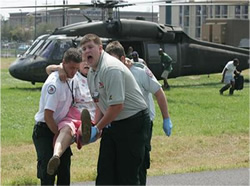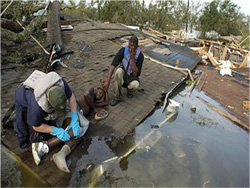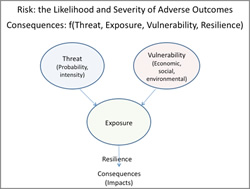
Elderly resident being evacuated in the aftermath of Hurricane Katrina.

Much of the worst flooding from Hurricane Katrina occurred in lower income neighborhoods.

Diagram of Risk and Consequences
ALEXANDRIA, VA – August 5, 2011. IWR has published “Social Vulnerability Analysis Methods for Corps Planning” as part of the Goal 2: Systems Approach of the USACE Campaign Plan. This handbook presents two practical methods for identifying socially vulnerable groups. It illustrates how social vulnerability, the drivers of vulnerability, and their spatial distribution in flood hazard zones can be used in the planning process. Such information assists in identifying problems and opportunities, developing planning objectives, creating and evaluating management measures, and evaluating project alternatives.
The two Social Vulnerability Analysis methods described are the Social Vulnerability Index and Social Vulnerability Profiling. Also included (Appendix A) are a number of supplemental social effects analysis tools that can work in tandem with the Social Vulnerability Index or Profiling methods. A coastal area in Chatham County, GA, is used to illustrate methods and procedures.
The experiences of Hurricanes Katrina, Rita, and Ike, as well as extensive flooding in the Upper Midwest, have again emphasized the reality and significance of the social impacts of floods. While all people living in flood hazard areas are affected, the social impacts of hazard exposure often fall disproportionately on the most vulnerable people in a society—the poor, minorities, children, the elderly, and the disabled. One of the lessons of Katrina and Rita has been that effects on socially vulnerable populations have been overlooked and underestimated.
Information on social vulnerability is essential to enrich understanding of issues and factors that are critical to developing sound plans. Vulnerable groups often have the fewest resources to prepare for a flood, live in the highest-risk locations, occupy substandard housing, and lack the knowledge or social and political connections necessary to access resources that would speed their recovery. Models for estimating the monetary costs and benefits of social effects are not part of current benefit-cost analysis used in the Corps project evaluation process. However, social effects are identified in other ways, quantifying effects when possible and describing them qualitatively when quantification is not possible. This paper adds additional tools to those efforts.
Learn More